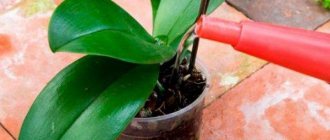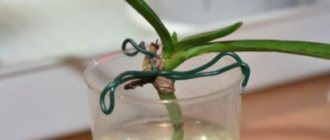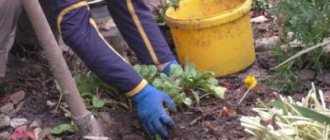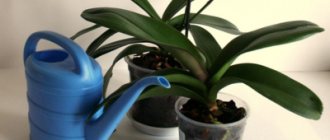How to revive an orchid? A similar question is usually asked by beginning flower growers who, out of ignorance or inexperience, have flooded the plant with water, which leads to rotting of the root system, or have minimized watering to such an extent that the flower has dried out. The question arises, is it possible to do something at home to breathe life into the orchid? Let's figure this out. Basically, it all depends on the specific situation. You need to understand exactly what happened to the plant, and then choose the right algorithm for solving the problem, if the flower can be saved at all.
Note! The most dangerous period for orchids is considered to be autumn-winter. This is explained by a drop in temperature outside, which leads to the need to turn on the heating system or appliances at home. This, in turn, leads to a decrease in air humidity and an increase in room temperature. Lighting also has its influence, which in winter is usually somewhat worse due to the fact that there is less daylight.
But in the warm season, orchids feel great. They can easily tolerate the absence of lighting, changes in humidity, and temperature changes. As a result, the grower must respond in a timely manner to the changing season and adjust the care of the plant, maintaining optimal conditions.
Why does an orchid die?
The main reasons for the death of the culture are the inconsistency of the conditions of detention with the requirements. Significant temperature changes, waterlogging of the substrate, and critical lack of lighting can be detrimental to it.
Most often, problems arise during the cold season. The flower reacts negatively to the following factors:
- dry air during heating operation;
- cold coming from the glass when kept on the window;
- watering with hard water;
- overheating or burns when exposed to sunlight;
- constantly wet substrate combined with low temperature;
- excess or improper application of fertilizers;
- violation of root aeration due to too compacted substrate;
- infection by insect pests or fungal diseases.
If the necessary conditions are not created and the factors affecting the well-being of the flower are not eliminated, it will soon begin to die.
How do you understand that Phalaenopsis has begun to perish and die?
You can determine that an orchid is experiencing problems by its appearance. It is worth paying attention to the presence of the following signs:
- sluggish, gradually yellowing leaves;
- yellowing of shoots, starting from the crown;
- absence of buds (more than 3 months);
- changing the position of the plant in the pot;
- drying and hanging of aerial roots;
- green plaque and algae inside the pot.
If at least one of these signs is present, it is worth removing the flower from the flowerpot and inspecting the root system. Signs of problems with roots:
- brown or black color;
- soft to the touch;
- release of liquid when pressed;
- filamentous structure.
How to revive rotten roots
Aerial orchid roots: transplantation and other options
How to revive an orchid if all the roots have rotted is not an easy question and requires special work.
You should understand! Rotten roots can no longer be saved, so they will need to be regrown.
Steps to solve the problem:
- Remove the flower from the pot
- Clear the root system of soil and rinse thoroughly.
- Trim off all rotten rhizomes using disinfected tools (knife or scissors). Only healthy tissue remains.
- Treat the sections with crushed charcoal and fungicide.
- If mold is detected, immerse the plant in a solution of potassium permanganate for a few minutes.
If the roots still remain after treatment, then it is necessary to transplant the plant into a substrate, but into a small pot. Be sure to provide the orchid with good lighting and a constant temperature of 22-25 degrees.
The orchid's roots are rotting
What to do if the plant is flooded?
Excessive moistening of the substrate is the main mistake of novice gardeners. The roots of an orchid are special, and you cannot water it like other crops. You can tell that a plant is flooded by the color of the roots in the pot. Then the leaves begin to wrinkle and the buds fall off. If measures are not taken, the flower will soon begin to die.
Important! Most often, overflow occurs if, when immersing a pot in a container of water, they forget to remove it in time. A substrate overflowing with moisture is detrimental to an orchid.
Eliminating flooding and overflow
The only way to cope with flooding or overflowing is to transplant the flower into a fresh substrate and replace the pot. Operating procedure:
- The plant is carefully removed from the pot. It cannot be pulled out, otherwise the roots will break. It is better to carefully cut the pot into two parts and remove them.
- The substrate is cleaned from the roots, washed with warm water and inspected.
- Use sharp, disinfected scissors to cut off the rotten parts.
- After drying, the sections are powdered with crushed charcoal or cinnamon.
- Spray the roots with fungicide and leave the rosette to dry for a day.
- Drainage is placed at the bottom of the new pot, freshly prepared substrate is poured in a thin layer and the orchid is placed on it. The free space between the roots is covered with substrate, leaving the root collar on the surface.
Carefully! Inexperienced gardeners try to dry a waterlogged substrate by heating it with a hair dryer. The hot air flow acts on the flower like a real hurricane. From such help he will not recover, but will definitely die!
How not to overwater an orchid?
The plant requires strictly controlled moistening of the substrate in different phases of development, at different temperature and humidity levels in the room. For an orchid, both overdrying and overmoistening are equally dangerous.
On average, the frequency of watering is as follows:
- during the active growing season - 2 times a week;
- during flowering and in very hot periods - every other day;
- during the rest period - once every 2-3 weeks.
When regulating moisture, it is also worth considering the type of orchid:
- Cymbidium, Phalaenopsis, Paphiopedilum are watered when perspiration disappears on the inside of the walls of the pot.
- Cattleya, Oncidium, Odontoglossum, Dendrobium require the substrate to dry completely before the next watering.
- Vanda needs daily spraying from a spray bottle.
Important! For irrigation, use exclusively soft, settled or filtered water at a temperature of 30-35 degrees.
Restoring the root system
So, what to do if you determine that the orchid is drying up due to damage to the root system? It is very easy to distinguish damaged roots from healthy ones. To do this, you need to carefully knock the plant out of the pot and carefully examine the roots. If they become brown, fibrous and brittle, then they are already dead. Normally they should be firm and green in appearance.
You can save an orchid even if the root system is completely lost. Therefore, you should not immediately throw out a damaged plant. The process of resuscitation of a damaged root system is as follows:
- Remains of substrate and moss are removed from the roots.
- Using a sharp knife, remove all dead and damaged areas. In this case, the knife must be disinfected with alcohol before use.
- The cut areas are burned with brilliant green or sprinkled with charcoal powder.
- The treated plant is transplanted into a fresh, slightly moist substrate.
Attention! For the first few days, you should not water a newly planted orchid. To reduce moisture loss, you can lightly spray the leaves several times a day.
In order to prevent damage to the roots in the future, you should know the main causes of this undesirable phenomenon:
- Low quality substrate. Moss and bark included in the substrate should not be very rotten. They should feel strong and dense to the touch. If, when you squeeze them between your fingers, they begin to crumble easily, then it’s time to replant the orchid. During the process of decomposition, the substrate begins to become moldy and rot, becoming a source of various putrefactive and fungal diseases. And also during watering, it begins to absorb too much moisture, which leads to waterlogging.
- Light mode. Plants suffer especially severely from disturbances in light conditions in the autumn-winter period. At home, during this period, the temperature reaches its maximum due to the heating being on, and the illumination is greatly reduced. This combination is very destructive for orchids. Gradually, their growth and development stop, and the roots begin to rot.
- Humidity level. Orchids are native to the tropics, so they need high humidity. Daily spraying with warm, settled water is very useful for them. But at the same time, you must ensure that the substrate in the pot dries out between waterings.
How to revive a flower at home?
The method of resuscitation of a dying flower depends on its condition and the problem that has arisen.
How to revive rotten roots?
Exotica with completely rotten roots are restored after their complete removal. The gardener’s task is to grow a new root system on the surviving rosette.
According to gardeners, the most effective way is to hang the rosette above the water:
- After removing the rotten roots, the sections are dried for several hours and treated with charcoal.
- Water is poured into a transparent vessel and the rosette is hung with a wire so that the lower part is located 1-2 cm short of the liquid.
- The container is installed in a warm (23-25 degrees) room in a place with diffused but intense lighting.
- During the process of growing roots, monitor the liquid level and add it as necessary. To prevent the leaves from drying out, they are wiped with a solution of succinic acid or the drug “Doctor Foley”. This will help the orchid gain strength and energy.
New roots are formed within 2-2.5 months. As soon as their length reaches 5-6 cm, the plant is planted in a pot with sphagnum moss. This material has good moisture capacity and at the same time increased breathability, which will help the weakened plant recover faster. After complete resuscitation and root growth, the orchid is transplanted into a substrate familiar to this type of plant.
How to save an orchid when it is overheated?
Keeping the crop in a too hot, dry room or in direct sunlight can also cause its death. Signs of overheating:
- wilting leaves (often with light spots or yellow tips);
- yellowish tint and wrinkling of roots;
- dryness and fragility of aerial roots.
If the plant overheats, remove it from the windowsill to a cool place to cool.
Important! A flower damaged by high temperature can be watered only after it has cooled, after 3-4 hours. Immediate moistening of the substrate will cause instant death of the roots!
How does a flower grow when there is not enough light?
Signs of a lack of lighting are wrinkled or small leaves of a dull shade. The flower looks drooping, unhealthy, and does not bloom for a long time. The roots gradually begin to rot as photosynthesis processes in them are disrupted.
It will be possible to revive the plant only if it is provided with bright, diffused lighting for at least 12 hours a day. The best place for growing is an east or west window. In winter or in cloudy weather, the orchid is illuminated with fluorescent or phytolamps.
If the plant is sick
Overmoistening or overheating of a crop is dangerous not only in itself. They provoke the development of diseases on the plant. Signs of diseases depend on their type:
- Fungal - appear as a white or gray coating, spots, stains on the leaves.
- Bacterial - cause rotting of roots, blackening of leaves and pseudobulbs, followed by their death. Often the leaves become covered with weeping spots, and an unpleasant odor emanates from the plant.
The drug Fitosporin has proven itself well in the treatment of fungal diseases. They are treated 2-3 times with an interval of 7 days.
Bacterial diseases can only be treated at an early stage. First, all affected parts of the plant are removed, healthy parts are wiped with antibiotic slurry. Experts advise using the drug Chlorhexidine. To restore after treatment, reduce watering and lower the temperature to 22-23 degrees.
How can you save an orchid?
The temperature is chosen to be average, usually not higher than 22 degrees. The lighting mode is made stable, but not excessive. In the first few days, the procedure is to soak the orchid in a container of water for 10 minutes. If there are no negative effects, daily soaking is continued, increasing the time to 1 hour or more.
Important! For many types of orchids, soaking can last up to a day, for example, resuscitation of Phalaenopsis.
In this article, we discussed how to save orchids without roots, carry out resuscitation in case of improper care and illness, and how to resurrect your favorite exotic pet.
Quick help for an orchid
In saving an exotic animal (when diagnosing problems), it is important to provide him with first aid correctly. Any violation of the appearance of the plant requires immediate action:
- swelling, plaque and yellowing of leaves is caused by a fungus. The affected parts are removed, the cut areas are treated with a fungicide;
- when bacterial spots appear on old leaves, they are pruned and treated with activated carbon;
- the plant with dried leaves and roots is transplanted into a new substrate;
- if voluminous waxy growths or holes are noticed on the leaves, treat them with insecticides against pests.
How to prevent Phalaenopsis from dying?
Careful adherence to recommendations for living conditions and care rules helps prevent problems when growing orchids:
- Compliance with watering standards. Phalaenopsis is a special flower that needs to be “watered” periodically. The next portion of moisture is added to the substrate only after the roots have absorbed the previous one. The root system must breathe, so it cannot constantly be in water.
- Providing intense lighting for at least 12-14 hours a day. Without a large amount of scattered sunlight, the plant loses its immunity. The roots weaken and cannot provide it with nutrients.
- Proper feeding. The main enemy of the orchid, which leads to rotting of the roots, is an excess of nitrogen. Fertilizing is carried out taking into account the phase of vegetative development of the plant. In this case, the dosage is reduced by 2-3 times to avoid overfeeding.
- Maintaining a humidity level of at least 60%. If there is not enough moisture in the air, the pot with the plant is placed on a tray with expanded clay. It must first be filled with water, an automatic humidifier must be installed in the room, and additional spraying of the leaves and roots should be carried out.
You shouldn’t throw away a limp, dried out or even rootless orchid. With some effort and patience, she can be saved. A life-loving flower will “take advantage of the chance for salvation,” the main thing is to choose the right method. Before using any method of resuscitation, you should first familiarize yourself with the recommendations of specialists and experienced flower growers. Wrong actions in this situation can aggravate the deplorable condition of the plant.
5 / 5 ( 1 voice )
Causes of orchid leaf loss
Sometimes the leaf blades of a plant begin to quickly die and the bush quickly loses its foliage. As a result, the orchid itself dies. This happens for various reasons, here are the most common ones.
End of flowering period
Sometimes after lush flowering the plant loses some of its leaves. If these are 1-2 leaf plates, then this should not worry the grower. It’s bad when the bush is left completely without leaves. If this happens, then it is worth finding the reason.
Losing a few leaves after flowering is a natural process.
Natural process
For an adult bush, losing one leaf per year is normal , if at the same time it grows new leaves. This is a natural process of aging of the lower leaves. And this should not cause concern to the gardener.
Poor root condition due to overwatering
When watering is carried out with enviable frequency and a large amount of water, the moisture from the soil does not have time to evaporate, under these conditions the root system of the plant can begin to rot.
A small number of roots will not be able to feed many leaves and the excess ones will begin to die. In this case, it is necessary to urgently begin to grow new roots so that the flower does not completely shed its foliage.
IMPORTANT! It is necessary to organize the correct watering regime with soft water.
Chemical burn of the root system with fertilizers
If the plant was fed with dry roots, this causes a burn to the root system and it begins to dry out. As the number of roots decreases, the amount of leaf mass decreases.
The flower is fertilized only after watering the wet root system.
Chemical burn of roots.
Drying out the plant
With rare watering, the orchid dries out part of its roots, since they do not receive the required amount of moisture. Then, as usual: no roots - no foliage. need to resuscitate the flower and grow its root system.
How to save a plant without leaves? We will answer further.











